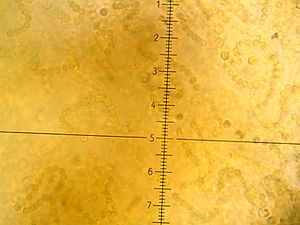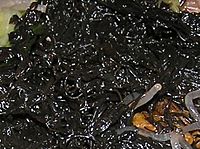Fat choy facts for kids
Quick facts for kids Fat choy |
|
|---|---|
 |
|
| Nostoc flagelliforme under a microscope | |
| Scientific classification | |
| Genus: |
Nostoc
|
| Species: |
flagelliforme
|
| Synonyms | |
| Fat choy | |||||||||||||||
|---|---|---|---|---|---|---|---|---|---|---|---|---|---|---|---|
 |
|||||||||||||||
| Traditional Chinese | 髮菜 | ||||||||||||||
| Simplified Chinese | 发菜 | ||||||||||||||
| Literal meaning | "hair vegetable" | ||||||||||||||
|
|||||||||||||||
| Alternative Chinese name | |||||||||||||||
| Traditional Chinese | 頭毛菜 | ||||||||||||||
|
|||||||||||||||
Fat choy (simplified Chinese: 发菜; traditional Chinese: 髮菜; Mandarin Pinyin: fàcài; Jyutping: faat³ coi³; Nostoc flagelliforme) is a terrestrial cyanobacterium (a type of photosynthetic bacteria) that is used as a vegetable in Chinese cuisine. When dried, the product has the appearance of black hair. For that reason, its name in Chinese means "hair vegetable". When soaked, fat choy has a soft texture which is like very fine vermicelli.
Production
Fat choy grows on the ground in the Gobi Desert and the Qinghai Plateau. Over-harvesting on the Mongolian steppes has furthered erosion and desertification in those areas. The Chinese government has limited its harvesting, which has caused its price to increase. This may be one reason why some commercially available fat choy has been found to be adulterated with strands of a non-cellular starchy material, with other additives and dyes. Real fat choy is dark green in color, while the counterfeit fat choy appears black.
Chinese culture
Its name in Cantonese sound the same as a Cantonese phrase meaning "struck it rich" (though the second syllable, coi, has a different tone) -- this is found, for example, in the Cantonese saying, "Gung1 hei2 faat3 coi4" (恭喜發財, meaning "wishing you prosperity"), often proclaimed during Chinese New Year. Therefore, it is a popular ingredient for the Chinese New Year, like in the reunion dinner. It is enjoyed as an alternative to cellophane noodles. It is mostly used in Cantonese cuisine and Buddhist cuisine. It is sometimes used as a hot pot ingredient.
Vietnamese culture
Fat choy is also used in Vietnamese cuisine. It is called tóc tiên or tóc thiêng (literally "angel's hair") in Vietnamese.

